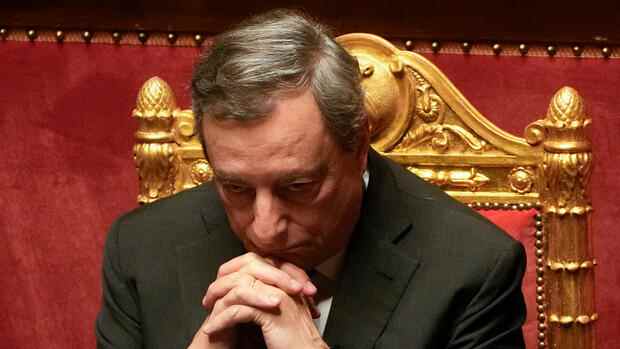The prime minister lacks the support of all coalition parties.
(Photo: dpa)
Rome Mario Draghi does not waste many words when he speaks in the Chamber of Deputies this morning. He smiles and thanks for the standing ovation from his ministers, for the applause from some parliamentarians – then he looks seriously at his speech and reads out just one sentence: “Against the background of last night’s vote in the Senate, I would like to ask you to interrupt the session because I go to the President of the Republic to tell him of my decision.”
Then Draghi leaves Parliament and rolls in his limousine towards the Quirinal Palace, the seat of the President. There the 74-year-old submitted his resignation again, this time it should be final.
“The President of the Republic has taken note of this,” declared the Quirinal Palace after the meeting with Sergio Mattarella. The government will initially remain in office for ongoing business.
On Wednesday evening, Draghi survived a vote of confidence in the Senate, the smaller chamber of parliament. However, three main government parties did not vote: the right-wing Lega, Forza Italia led by ex-Prime Minister Silvio Berlusconi and the left-wing Five Star Movement.
Top jobs of the day
Find the best jobs now and
be notified by email.
The government crisis has been going on for a week now. The trigger was a vote on a billion-dollar stimulus package, in which the five stars abstained. In addition to aid for families and companies in the current energy crisis, the package also included the construction of a waste incineration plant in Rome that had been planned for decades – for many observers the real reason why the Left Party did not vote for it.
Three scenarios are possible
Draghi had already submitted his resignation to Mattarella after last Thursday’s vote – but the President did not accept it and called on Draghi to speak in Parliament and sound out his majorities. On Wednesday Draghi tried one last time to unite the divided coalition behind him. In vain, as the vote of confidence showed.
Italy’s president actually wants to prevent new elections.
(Photo: via REUTERS)
The future of Italy is once again in Mattarella’s hands. Three scenarios are conceivable. Scenario one: Mattarella explores a new majority with the current governing parties. He could once again persuade Draghi to continue. Scenario Two: Mattarella appoints an interim prime minister to rule the remaining legislature through early summer 2023. Scenario three: Mattarella dissolves both houses of parliament, which would lead to early elections.
Scenario one is the most unlikely. Draghi would thus bow to pressure from the center-right parties in his government, who wanted to continue with the prime minister, but no longer in the old five-star constellation. For Draghi, that would mean a major loss of face.
Scenario two is more realistic because Mattarella actually wants to avoid snap elections at all costs. There has never been an election in Italy in the fall because the household budget is being debated during that phase. Possible names for an interim prime minister have been haunting Rome for a week, above all that of former prime minister and constitutional judge Giuliano Amato.
The most likely scenario based on the current status are new elections. They would be held in late September or early October. This means that Italy is threatened with a power vacuum that will last for months, and that in a very sensitive phase with the Ukraine war, the next wave of corona, a weakened economy, high inflation and the energy and drought crisis.
Markets are already in turmoil
In the meantime, Italy would hardly be able to act politically, although it actually has to implement important reforms in order to secure further billions in tranches of EU aid. An election campaign could also have negative consequences for the reputation and stability of the heavily indebted Mediterranean country if, for example, investors are deterred by the uncertainties. The post-fascists (“Brothers of Italy”) are currently ahead in the polls.
>>Read here: Ukraine War and Euro Stability – What are the Consequences of Italy’s Government Crisis for Europe?
Investors are already withdrawing from Italy due to uncertainty about the political future. For example, Italian government bonds flew out of the depots on Thursday, causing the yield on ten-year titles to rise to a three-week high of 3.62 percent. This hit Italian banks, which traditionally hold large amounts of these bonds. The Milan industry index slipped by up to five percent.
Italy’s bonds plummeted on Wednesday after Draghi failed to garner enough support from his coalition partners. The yield on the 10-year bond jumped up to 19 basis points to 3.58 percent. The distance to equivalent German bonds (spread) rose to 232 basis points.
With agency material
More: Draghi wins confidence vote – but new elections are more likely
